DfE Report Highlights Regional Gaps in University Access Across England
Disadvantaged Pupils in Inner London Twice as Likely to Enter Top Universities
In a striking divergence from national patterns, young people from low-income families in inner London are entering university at significantly higher rates than their counterparts elsewhere in England. According to a recent report from the Department for Education, more than half of pupils eligible for free school meals (FSM) in inner London had progressed to higher education by the age of 19 during the 2023–24 academic year. This figure stands in sharp contrast to the national average, where fewer than 46% of young people from all backgrounds pursued university education. Moreover, in a quarter of local authorities outside the capital, fewer than one in five FSM pupils enrolled in higher education. Notably, one in ten FSM pupils from inner London secured places at selective universities—twice the rate observed elsewhere.
Professor Graeme Atherton attributed this success to strong GCSE outcomes and cultural influences, noting that non-white students—who form the majority in inner London—are more likely to pursue university education regardless of academic performance. He further emphasised that the capital’s dense concentration of universities enhances accessibility, while the presence of peers from similar backgrounds fosters a supportive environment.
In addition, Sarah Hannafin, head of policy at the National Association of Head Teachers, stressed that a child’s educational prospects should not be constrained by family income or geographic location. Department for Education data also indicated that the participation gap between disadvantaged and affluent students has narrowed, largely due to the strong performance of London’s FSM pupils, particularly in admissions to selective institutions.
Nevertheless, national enrolment figures declined in 2023–24, with Atherton describing the trend as stagnant following the post-COVID surge. A higher education expert suggested that rising student poverty may be discouraging some teenagers from pursuing university, as they are increasingly aware of the realities of student life through social media and peer experiences. Despite this, overall demand remains steady, albeit with marked regional disparities.
Recent statistics revealed that 80.6% of A-level students aged 17 progressed to higher education by age 19, a drop of over two percentage points from 2022–23. Among all state school pupils aged 15, the progression rate fell from 46.9% to 45.8% in the same period. The report also highlighted a notable exception among Black students, whose progression rate rose to 63.3%, the highest increase of any ethnic group since 2009 and the only group to demonstrate consistent year-on-year growth. In contrast, White pupils recorded the lowest rate, with just 40.5% entering higher education by age 19. Inner London’s success in widening university access for disadvantaged youth underscores the urgent need to replicate such inclusive strategies across the country.
Editor’s Note:
The recent data from the Department for Education highlights a significant rise in university participation among disadvantaged pupils in inner London. Young people from low-income families in the capital, particularly those eligible for free school meals, are progressing to higher education at higher rates than their counterparts in other regions. The data reflects the positive influence of sustained academic achievement, cultural aspirations, and the accessibility provided by London’s numerous universities. However, the report also underscores ongoing regional disparities and a national decline in university enrolments. While inner London shows encouraging trends, the gap in selective university admissions between regions points to the need for more inclusive and regionally targeted education policies. This analysis contributes to current discussions on equity in higher education and the broader structural factors shaping student outcomes across England.
Skoobuzz views these trends as both promising and cautionary, highlighting inner London’s success while emphasising the urgent need for equitable higher education access across all regions.














0 Comments (Please Login To Continue)